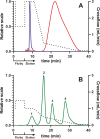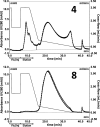Validation of an FFF-MALS Method to Characterize the Production and Functionalization of Outer-Membrane Vesicles for Conjugate Vaccines
- PMID: 36007249
- PMCID: PMC9453738
- DOI: 10.1021/acs.analchem.2c01590
Validation of an FFF-MALS Method to Characterize the Production and Functionalization of Outer-Membrane Vesicles for Conjugate Vaccines
Abstract
With the ongoing development of conjugate vaccines battling infectious diseases, there is a need for novel carriers. Although tetanus toxoid and CRM197 belong to the traditional carrier proteins, outer-membrane vesicles (OMVs) are an excellent alternative: in addition to their size, OMVs have self-adjuvanting properties due to the presence of genetically detoxified lipopolysaccharide (LPS) and are therefore ideal as a vaccine component or antigen carrier. An essential aspect of their development for vaccine products is characterization of OMVs with respect to size and purity. We report on the development of a field-flow fractionation multiangle light-scattering (FFF-MALS) method for such characterization. Here, we introduced NIST-traceable particle-size standards and BSA as a model protein to verify the precision of the size and purity analysis of the OMVs. We executed a validation program according to the principles provided in the ICH Guidelines Q2 (R1) to assess the quality attributes of the results obtained by FFF-MALS analysis. All validation characteristics showed excellent results with coefficients of variation between 0.4 and 7.32%. Estimation of limits of detection for hydrodynamic radius and particle concentration revealed that as little as 1 μg OMV still yielded accurate results. With the validated method, we further characterized a full downstream purification process of our proprietary OMV. This was followed by the evaluation of other purified OMVs from different bacterial origin. Finally, functionalizing OMVs with N-γ-(maleimidobutyryl)oxysuccinimide-ester (GMBS), generating ready-to-conjugate OMVs, did not affect the structural integrity of the OMVs and as such, they could be evaluated with the validated FFF-MALS method.
Conflict of interest statement
The authors declare no competing financial interest.
Figures




Similar articles
-
Determination of particle number concentration for biological particles using AF4-MALS: Dependencies on light scattering model and refractive index.J Chromatogr A. 2024 Nov 22;1737:465460. doi: 10.1016/j.chroma.2024.465460. Epub 2024 Oct 19. J Chromatogr A. 2024. PMID: 39476775
-
Glycoengineered Outer Membrane Vesicles as a Platform for Vaccine Development.Methods Enzymol. 2017;597:285-310. doi: 10.1016/bs.mie.2017.06.032. Epub 2017 Aug 18. Methods Enzymol. 2017. PMID: 28935107
-
Outer membrane vesicles engineered to express membrane-bound antigen program dendritic cells for cross-presentation to CD8+ T cells.Acta Biomater. 2019 Jun;91:248-257. doi: 10.1016/j.actbio.2019.04.033. Epub 2019 Apr 17. Acta Biomater. 2019. PMID: 31003032
-
Outer membrane vesicles (OMVs) enabled bio-applications: A critical review.Biotechnol Bioeng. 2022 Jan;119(1):34-47. doi: 10.1002/bit.27965. Epub 2021 Nov 6. Biotechnol Bioeng. 2022. PMID: 34698385 Review.
-
Spheres of influence: Porphyromonas gingivalis outer membrane vesicles.Mol Oral Microbiol. 2016 Oct;31(5):365-78. doi: 10.1111/omi.12134. Epub 2015 Oct 23. Mol Oral Microbiol. 2016. PMID: 26466922 Review.
Cited by
-
GMMA decorated with mucin 1 Tn/STn mimetics elicit specific antibodies response and inhibit tumor growth.NPJ Vaccines. 2025 Apr 15;10(1):71. doi: 10.1038/s41541-025-01127-8. NPJ Vaccines. 2025. PMID: 40234452 Free PMC article.
References
-
- Peltola H. Worldwide Haemophilus influenzae type b disease at the beginning of the 21st century: global analysis of the disease burden 25 years after the use of the polysaccharide vaccine and a decade after the advent of conjugates. Clin Microbiol Rev 2000, 13, 302–317. 10.1128/CMR.13.2.302. - DOI - PMC - PubMed
-
- Ilyina N.; Kharit S.; Namazova-Baranova L.; Asatryan A.; Benashvili M.; Tkhostova E.; Bhusal C.; Arora A. K. Safety and immunogenicity of meningococcal ACWY CRM197-conjugate vaccine in children, adolescents and adults in Russia. Hum. Vaccines Immunother. 2014, 10, 2471–2481. 10.4161/hv.29571. - DOI - PMC - PubMed
MeSH terms
Substances
LinkOut - more resources
Full Text Sources

